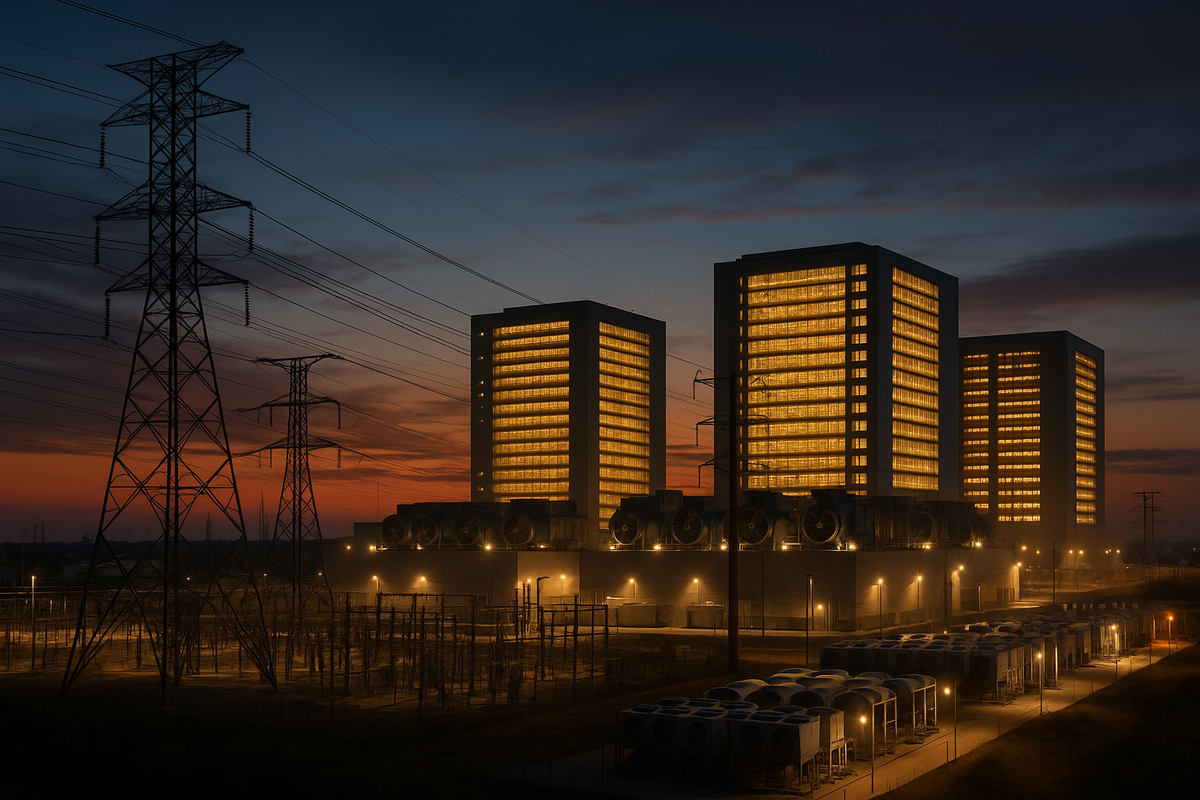AI’s Electric Empire: Sectoral Load Growth and the Grid Divide
AI is reshaping U.S. electricity demand, driving growth in hyperscale data centers, enterprise applications, industrial AI, and edge computing. This surge, concentrated in specific regions, is reshaping the grid, creating challenges for transmission planning and infrastructure.

Nowhere is that truer than in the emerging electric geography of artificial intelligence. The rise of AI has not merely altered the nature of computation; it has reshaped the very structure of electricity demand in the United States. It is not a monolithic ascent, but a jagged, sector-specific surge, concentrated in a handful of hyperscale clusters and leaking at the margins into industrial, enterprise, and edge applications.
The bulk of the growth—the gravitational center of AI’s energy appetite—is the realm of the hyperscalers. These are the titans of the cloud: Amazon Web Services, Google Cloud, Microsoft Azure, Meta, and a few others who, in their pursuit of compute supremacy, are transforming the electrical load profile of entire states. Their ambitions are not modest. In 2023 alone, the capital investment by these firms in data centers exceeded the capital expenditures of the entire U.S. oil and gas industry. More than 0.5 percent of U.S. GDP now flows into these sprawling server campuses—cathedrals of code that consume power on the scale of small cities.
These hyperscale data centers, often exceeding 100 megawatts each, are being constructed with speed and precision, outfitted with tens of thousands of GPUs and AI-specific chips. The result is a new species of infrastructure: ultra-dense, always-on, and ruthlessly efficient. A single large AI data center can draw between 100 and 150 megawatts—equivalent to the electricity usage of hundreds of thousands of homes. Yet, for the operators, electricity remains a manageable cost. Power accounts for roughly 20 percent of operating expenses, while AI services themselves command high margins. The incentive is clear: build bigger, train faster, infer more.
This appetite for power is not only tolerated but strategically absorbed by grid operators who are eager to partner with these high-revenue companies. In many cases, hyperscalers pay a premium to secure reliable electricity, which enables utilities to justify large-scale infrastructure upgrades that would be politically or economically difficult otherwise. As a result, hyperscalers are not just technology companies—they are becoming silent partners in reshaping regional grid architecture.
By contrast, the world of enterprise and small-scale data centers has entered a different phase. In the 2010s, many companies migrated their digital workloads to the cloud, consolidating their compute environments and shedding older, inefficient server closets. Today, those remaining enterprise data centers are fewer in number, often more efficient, and growing more slowly. Some remain essential—especially in sectors like finance or healthcare that require low-latency or data sovereignty. But the trend is unmistakable: the center of gravity has shifted from thousands of diffuse, inefficient rooms to fewer, denser, professionally managed cloud campuses.
Yet this shift does not mean the enterprise sector is static. Financial institutions are deploying AI for fraud detection, biotech firms are integrating machine learning into genomics, and media companies are using generative models for content. These applications are triggering modest upgrades to on-premise clusters, typically under 5 MW. In aggregate, the sector represents thousands of sites and a slowly rising tail of energy consumption, albeit far overshadowed by hyperscale growth. A notable outcome of this shift is a transition from energy-inefficient server closets with poor cooling to data environments that approach the power usage effectiveness (PUE) metrics of large cloud players. This yields a net gain in energy efficiency but also centralizes risk and reshapes power distribution.
In industry, a third axis of AI-driven load growth is emerging—quieter, less spectacular, but no less significant. Manufacturers, energy firms, and research labs are increasingly adopting AI for automation, predictive maintenance, and simulation. These industrial AI clusters, often ranging from 1 to 5 megawatts, are embedded directly in factories or field sites. An oil firm might deploy GPU-based servers for seismic analysis; an automaker might run AI models for autonomous driving. While their collective load is smaller than that of the hyperscalers, it is growing steadily. As Industry 4.0 unfolds, even the most traditional plants are beginning to hum with machine learning.
Consider a steel mill that integrates real-time sensor feedback and AI analytics to predict mechanical failures before they occur, reducing downtime and boosting output. Or a pharmaceutical manufacturer using AI-assisted microscopy to analyze biological samples on site. These examples illustrate how AI is no longer confined to digital-native companies but is infiltrating legacy industries and changing how they consume power.
Then there is the edge—the digital frontier where data meets geography. Here, AI is being deployed in miniature: small inference servers at telecom exchanges, regional micro-data centers, or even cell towers. These facilities, typically only a few kilowatts to a few hundred kilowatts each, might seem trivial. But in aggregate, they are anything but. As 5G networks expand and IoT devices proliferate, analysts forecast a vast mesh of edge deployments contributing to national electric load. The trend is both decentralizing and compounding: inference moves closer to the user, and energy demand becomes more distributed across the grid.
By 2030, edge computing may emerge as the most significant vector of AI infrastructure that the public never sees. Telecom companies, content distributors, and logistics firms are quietly deploying hardware in physical spaces that were once considered marginal: shipping centers, roadside hubs, even utility poles. These installations may only draw a few kilowatts individually, but with thousands or tens of thousands across the country, they represent a nontrivial slice of the national load curve.
Taken together, these sectoral distinctions are not academic. They matter deeply to grid planners and policymakers. Hyperscale facilities impose sharp, concentrated demands on transmission systems. Enterprise and industrial loads are more distributed and modulated. Edge computing adds countless small nodes, increasing the complexity of distribution planning. Load forecasting, once a relatively stable art, is being remade in real time.
Nowhere is this regional reshaping more visible than in Northern Virginia. Loudoun County’s now-infamous "Data Center Alley" is home to the highest concentration of data centers on the planet. By 2023, data centers consumed over one-quarter of Virginia’s total electricity. Dominion Energy’s sales to data centers surpassed 24 percent of its load. Projections suggest that NOVEC’s peak demand could rise 12 percent annually for the next decade and a half—almost entirely due to hyperscale expansion.
This growth is not without strain. Dominion has scrambled to build substations and high-voltage lines. Regulators have convened emergency planning groups. Community resistance is mounting. In 2022, a grid fault nearly triggered a cascading failure when a 1,500-megawatt cluster of data centers went offline in unison. PJM had to curtail generation to prevent over-frequency. The North American Electric Reliability Corporation now treats such outages as critical risks.
Texas, too, is feeling the heat—literally and figuratively. In the deregulated ERCOT market, data centers and crypto mining operations have driven a 10 percent increase in commercial-sector electricity use since 2019. Several "near-miss" events have occurred when large computing loads dropped off the grid unexpectedly, causing destabilizing frequency shifts. ERCOT has since revised interconnection rules, requiring greater coordination and contingency planning.
Other regions are following suit. Iowa and Oregon have drawn hyperscalers with wind and hydro. Arizona and Georgia are seeing surges around urban cores. Even North Dakota is in the game, with data center load growing over 37 percent in four years. States with cheap power, land, and favorable tax regimes are being scouted for future campuses. In some cases, retired coal plants are being repurposed—their substations and cooling systems reborn as backbones for AI.
The siting logic is increasingly strategic. Cool climates offer natural advantages for thermal management. Proximity to renewable energy improves ESG optics and supports net-zero commitments. Access to fiber, tax abatements, and favorable zoning round out the picture. Yet constraints are growing: land is tightening, community pushback is mounting, and grid capacity is becoming the new gold standard for site selection.
The infrastructure timeline presents a paradox. A data center can be built in 18 months. A transmission line takes five to seven years. This misalignment is becoming a bottleneck. Utilities are racing against time, designing substations, high-voltage loops, and backup generation schemes just to keep pace.
Ultimately, the AI revolution is not just about silicon and algorithms. It is about steel, concrete, and copper. It is about where the electrons go, how fast they must arrive, and who pays to ensure they get there. It is about a reshaping of the physical grid to match the demands of synthetic minds.
In this future, utilities become partners in digital infrastructure. Transmission developers become enablers of intelligence. And planners must build not only for growth but for resilience—because the margin for error is narrowing.
Sector by sector, region by region, the electricity map of the United States is being redrawn. Some places surge ahead; others remain unchanged. But the trend is unrelenting. The machines may think in the cloud, but they draw their power from the earth. And as AI grows, so too must the grid that feeds it.
That is the future, arriving unevenly, on the backs of transformers and transmission towers.


